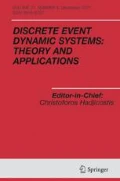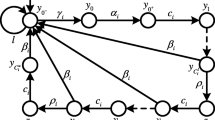Abstract
The aim of this paper is the generation of the min-critical and max-critical subsystems which determine the optimal cycle times. Considering a Time Interval Model which can describe Timed Event Graphs and P-time Event Graphs completely, each critical subsystem depends on the lower and upper bounds of the time durations. The proposed approach which is based on linear programming makes a classification of the relations which describe the system. The application to a baking process in a plant bakery shows that the min-critical and max-critical subsystems are not limited to the critical circuits of the Event Graph.

Similar content being viewed by others
References
Baccelli F, Cohen G, Olsder GJ, Quadrat JP (1992) Synchronization and Linearity. An Algebra for Discrete Event Systems, available from http://maxplus.org, New York, Wiley
Bernardi S, Campos J (2013) A min-max problem for the computation of the cycle time lower bound in interval-based Time Petri Nets, IEEE Transactions on Systems, Man, and Cybernetics: systems, 43(5)
Declerck P (2013) Cycle Time of a P-time Event Graph with Affine-Interdependent Residence Durations. Journal of Discrete Event Dynamic Systems, available on http://perso-laris.univ-angers.fr/~declerck/
Declerck P (2018) Extremum Cycle Times in Time Interval Models. IEEE Trans. Autom. Control 63(6):1821–1827. http://perso-laris.univ-angers.fr/~declerck/
Giua A, Piccaluga A, Seatzu C (2000) Optimal token allocation in timed cyclic Event-Graphs, Proc. 4th Workshop on Discrete Event Systems, pp 209–218
Gros C (2000) DEA Report in ”Biotechnologies et Industries Alimentaires”, Ecole Nationale supérieure d’Agronomie et des Industries Alimentaires, ENSAIA, INPL
Lee T-E, Park S-H, Jung C (2014) Steady State Analysis of Timed Event Graph with Time Window Constraints. Applied Mathematics 167:202–216
Hanen C, Munier Kordon A (2009) Periodic schedules for linear precedence constraints. Applied Mathematics 157(2):280–291
Murata T (1989) Petri nets: properties, analysis and applications. Proceedings of the IEEE 4:77
Rodríguez RJ, Júlvez J (2010) Accurate Performance Estimation for Stochastic Marked Graphs by Bottleneck Regrowing. From book Computer Performance Engineering - 7th European Performance Engineering Workshop, EPEW, 2010, Bertinoro, italy, september 23-24, 2010, Proceedings, pp 175–190
Schrijver A (1987) Theory of linear and integer programming John Wiley and Sons
Author information
Authors and Affiliations
Corresponding author
Additional information
Publisher’s note
Springer Nature remains neutral with regard to jurisdictional claims in published maps and institutional affiliations.
Rights and permissions
About this article
Cite this article
Declerck, P. Critical subsystems in time interval models. Discrete Event Dyn Syst 31, 25–35 (2021). https://doi.org/10.1007/s10626-020-00322-0
Received:
Accepted:
Published:
Issue Date:
DOI: https://doi.org/10.1007/s10626-020-00322-0




